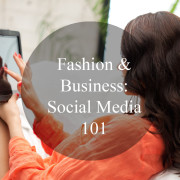Branding and Communications for Emerging Designers (Part 1)
Are you a designer with a great collection? Perfect. Now you just need to sell it by using branding and communications; you need to let others know of your amazing designs! This is a three part series aimed at giving emerging designers the top branding and communications tips they need for their businesses.
In order to understand how to brand a collection let’s start with the basics of communications and branding.
Communication refers to the reception and/or broadcasting of information, news, ideas, feelings, etc. This happens by speaking, writing or any other mediums. This communication drives the connection of people or places and meaning.
“ Strategic communication is coordinating the things you do and say in support of your objectives. More formally, I define strategic communication as coordinated actions, messages, images, and other forms of signaling or engagement intended to inform, influence, or persuade selected audiences (…)”
-Christopher Paul, Strategic Communication: Origins, Concepts, and Current Debates
Branding is creating a unique name and image for a product or range of products in the consumers’ mind. Branding focuses on influencing the perception of customers as an image or impression is built in the mind of customers. The idea of branding came up when the product itself was not enough in the midst of many competitors. Branding gave more options for the customers to choose from: the brand was an added value to the product. Customers could recognize their set of values through the brand.
“ Brand is the image people have of your company or product. It’s who people think you are. Or quoting Ze Frank, it’s the “emotional aftertaste” that comes after an experience (even a second-hand one) with a product, service or company. (Also, it’s the mark left after a red-hot iron is applied to a steer’s hindquarters.)”
-Ann Handley , Author with C.C. Chapman of Content Rules
The Millward Brown Pyramid is an extremely simple visual of what builds a brand and customer loyalty.

The next important step is creating a Presence – customers have to notice your brand. Consider how your products can be sold and where: will your products be located online? In a brick and mortar store? Do you want to concentrate on your local market or reach other countries? If you will reach an international market, are you ready to ship products overseas? Deciding on your target market will help this process and improve communication as well. By simply deciding on location, you can assess the selling platforms that will best be accessible. An example is having your target be an international market. The easiest method would be to contact the appropriate websites that have reach many consumers. In contrast, brick and mortar distributors may be better for local markets.
After you succeed choosing how to create your presence, the next step is to think of the type of customer and their needs. This is your Relevance.
What type of customer will be interested in your products? What type of customers are you interested in? And most importantly, how much is your target customer willing to spend? Because the customer has so much influence over the price, you must consider your market when determining price points that are relevant to them. Factors to consider are: customer’s age, shopping patterns, revenue, and interests. In order to build a strong brand relevant to your target, you have to understand your customer.
Finally, how do you compare with other brands? This depends on your brand’s Performance. Performance adds value among other competitors. Understanding what already exists in the fashion industry is vital to the growth of your brand. What are some strengths/weaknesses of other brands? Where do you fit in? Asking these questions and taking what you’ve learnt about your brand will allow you to stand out. Being unique is not hard to do once you find what is unique to your brand.
A factor in addition to your brand’s performance is the Advantage it has. There will be many comparisons to be made based on the quality and pricing of your products, but what makes your brand truly stand out? This can be done in many ways through your engagement with customers and the customer service you provide. Whatever can contribute to the brand’s essence and values to help the customer relate to it is valuable.
After your customer has identified with your brand and products, you’ve Bonded with them. Hopefully ,the customer will become a loyal follower and continue to support your brand.
As you can see, communication and brand building takes a lot of work, but the most important part is understanding the customer and who you’re designing for. With the foundation, the next steps will be easier to build upon.
Stay tuned for practical steps to branding (Part 2/3)!
This article was written by Alexandra. Follow her on Twitter @Stylindublin
Are you looking for a new writing opportunity? Perhaps you have style tips that you would like to share with the world? We value new fashion trends and are always looking for talented guest bloggers. If you’re a blogger or writer, this is the place for you to get noticed. Can you see yourself as a part of our blogging team? Apply here!











